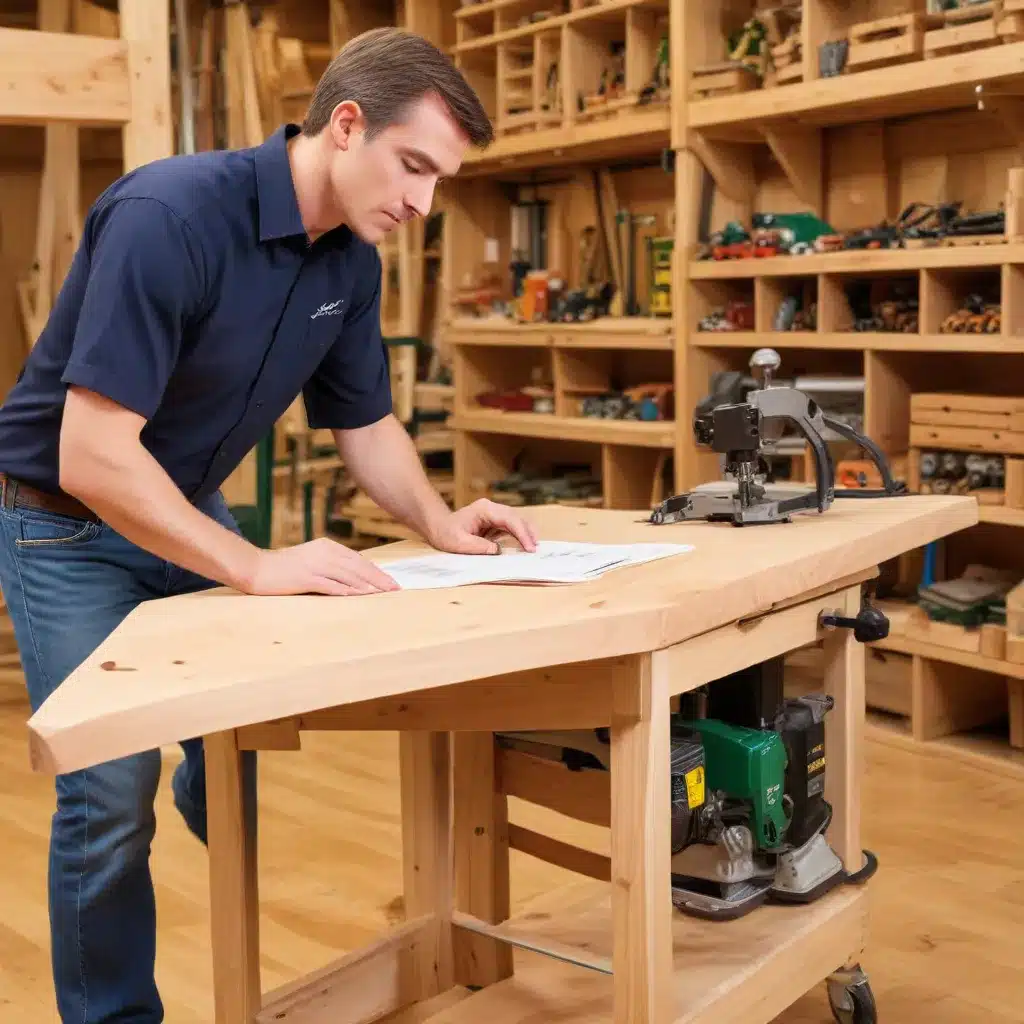
Optimizing Workstations for Woodworkers
As a seasoned woodworker, I know all too well the physical demands of our craft. The repetitive motions, heavy lifting, and prolonged standing can take a toll on our bodies if we don’t prioritize ergonomics in our workshops. That’s why I’m passionate about sharing my insights on designing ergonomic workstations that prioritize comfort and efficiency.
Woodworking is a physically demanding profession, and poor workstation design can lead to discomfort, fatigue, and even serious injuries over time. Musculoskeletal disorders (MSDs) are a common concern for woodworkers, and they can significantly impact our productivity and well-being. That’s why it’s crucial to incorporate ergonomic principles into the layout and design of our workshops.
Adjustable Work Surfaces
One of the key considerations in creating an ergonomic woodworking workstation is the adjustability of work surfaces. Whether it’s a workbench, table, or cutting station, the height should be easily adjustable to accommodate workers of different heights. This allows us to work at a comfortable level, reducing strain on our backs, shoulders, and necks.
Adjustable work surfaces also enable us to switch between sitting and standing positions, which can help alleviate fatigue from prolonged standing. Transitioning between these postures can improve blood circulation and reduce the risk of musculoskeletal issues. 3M™ Hot Melt Applicators are a great example of tools designed with ergonomics in mind, featuring lightweight construction and comfortable grip handles to minimize strain during extended use.
Proper Tool Placement
Another critical aspect of ergonomic woodworking is the placement of our tools. Saws, drills, sanders, and other essential equipment should be positioned within easy reach, without requiring excessive reaching, bending, or twisting. This minimizes the strain on our arms, shoulders, and back, reducing the risk of injuries.
Organizing and storing our tools in a way that promotes good posture is also essential. By keeping frequently used items close at hand and arranging them in a logical, accessible manner, we can minimize the need for awkward body movements and maintain a comfortable working position.
Lighting and Seating
Adequate lighting is another crucial factor in creating an ergonomic woodworking environment. Poor visibility can lead to eye strain, fatigue, and increased risk of mistakes that can result in injuries. Providing ample task lighting, such as adjustable lamps or overhead lighting, ensures we can see our work clearly and accurately.
For those of us who need to sit for prolonged periods, such as when operating a lathe or doing delicate work, comfortable seating is a must. Ergonomic chairs with adjustable height, backrest, and lumbar support can help us maintain good posture and alleviate the discomfort associated with extended sitting.
Respiratory and Visual Protection
In addition to the physical aspects of ergonomics, it’s important to consider the safety and protection of our respiratory and visual systems. Woodworking can expose us to various airborne particles, including dust, fumes, and other hazardous materials.
Investing in a high-quality respirator, such as the Integra P100 Respirator, can provide 99.97% filtration efficiency against these particles, safeguarding our lungs and respiratory health. The integrated safety goggles on this respirator also offer added eye protection, ensuring we can work safely and effectively in challenging woodworking environments.
Flooring and Matting
The type of flooring and matting used in our workshops can also impact our ergonomics. Selecting non-slip, cushioned flooring can help reduce the strain on our joints and muscles from prolonged standing. Anti-fatigue mats can provide additional comfort and support, further minimizing the risk of injuries caused by extended periods on our feet.
Adapting to Individual Needs
It’s important to remember that ergonomics is not a one-size-fits-all solution. Each woodworker has unique physical characteristics, preferences, and work habits. As we design our workstations, it’s crucial to consider the individual needs and preferences of each team member.
Encouraging feedback and input from the woodworkers themselves can help us tailor the workspace to their specific requirements. By fostering a collaborative approach, we can create a workspace that truly optimizes comfort, efficiency, and safety for everyone involved.
Continuous Improvement
Ergonomics in woodworking is an ongoing process, not a static solution. As our tools, techniques, and work environments evolve, we must remain vigilant in assessing and improving the ergonomic design of our workshops.
Regular evaluations, incorporating feedback from woodworkers, and staying up-to-date with the latest ergonomic research and best practices can help us continuously refine and optimize our workstations. By embracing a culture of continuous improvement, we can ensure that our workshops remain comfortable, efficient, and safe for generations of woodworkers to come.
Embracing Ergonomics
As a seasoned woodworker, I understand the importance of prioritizing ergonomics in our craft. By designing workstations that prioritize comfort, efficiency, and safety, we can not only protect our physical well-being but also enhance our productivity and job satisfaction.
Remember, our workshops are more than just a collection of tools and materials – they are our workspaces, our creative sanctuaries, and our livelihood. By investing in ergonomic design, we’re not just taking care of our bodies, but also nurturing our passion for woodworking and ensuring its longevity.
So, let’s embrace the principles of ergonomics and create workspaces that truly support us as woodworkers. With adjustable surfaces, proper tool placement, adequate lighting and seating, and the right respiratory and visual protection, we can unlock new levels of comfort, efficiency, and safety in our craft.
After all, our workshops are the heart and soul of what we do. Let’s make them a place where we can thrive, both physically and creatively. Let’s visit woodcraftparts.net to explore the latest tools and accessories that can help us achieve our ergonomic goals.

